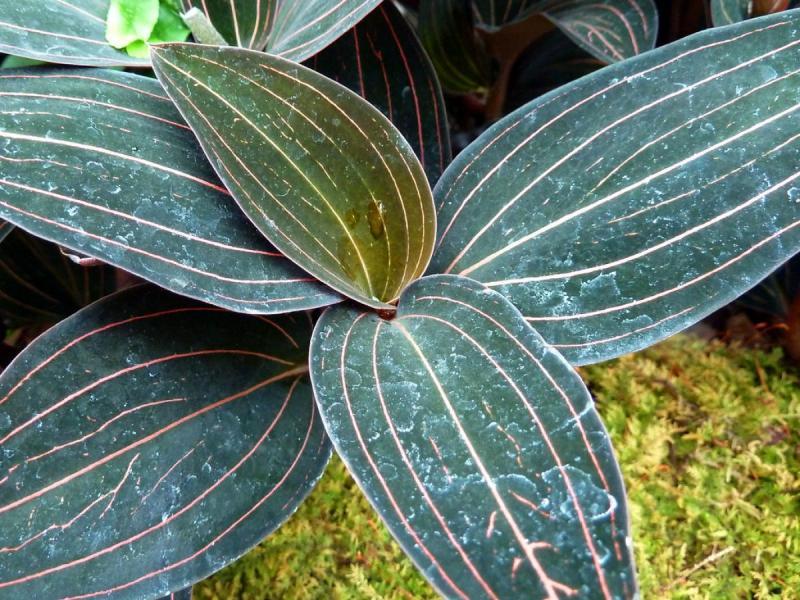Ludisia discolor
Also known as: The Jewel Orchid or Haemaria discolor h.f. alba Ludisia discolor var. ordiana Ludisia discolor h.f. variegata Ludisia discolor var. dawsoniana Ludisia discolor h.f. discolor Ludisia otletae Ludisia dawsoniana Haemaria otletae Ludisia discolor h.v. nigrescens Goodyera dawsoniana Ludisia discolor h.f. alba Haemaria pauciflora Ludisia discolor h.v. nigricans Kuhlhasseltia carrii Anoectochilus ordeanus Dicrophyla elegans Anoectochilus dawsonianus Ludisia discolor h.v. dawsoniana Anoectochilus ordianus Haemaria discolor var. dawsoniana Anoectochilus rubrovenia Haemaria dawsoniana Haemaria discolor h.v. nigricans Goodyera rodigasciana Goodyera ordiana Myoda rufescens Goodyera rubrovenia Goodyera ordeana Haemaria discolor var. ordeana Haemaria discolor var. concolor Haemaria discolor var. condorensis Haemaria discolor var. denisoniana Haemaria discolor var. grandis Ludisia odorata Haemaria discolor var. rhodoneura Haemaria discolor var. trilineata Haemaria rubrovenia Ludisia furetii The Differently Colored Ludisia In Thailand Phak biae chang in the subfamily: Spiranthoideae
Native to: Guangdong - China India Indonesia Yunnan - China
General Information
The Jewel Orchid is a cool to warm growing lithophytic or terrestrial orchid belonging to the sub family Spiranthoideae native to China, India and Indonesia.
Plant Description
Grows to 15cm. Each new growth has numerous thick erect, oblong shaped leaves that grow to 2.5-7.5cm long. The plant tends to climb or sprawl with each new growth
Flowers
Numerous fragrant blossoms appear
Fragrance
The orchid is fragrant.
Substrate(s)
- Coarse
- Medium
- Bark
- Charcoal
- Treefern
- Spaghnum Moss
- Perlite
Care Notes
These orchids like to be watered regulary, especially during warm weather, and prefer a well draining mix or also do well mounted, provided they can be watered daily or even many times a day.
These are quite a forgiving orchid, there are no special requirements to get this orchid to flower, just good care and consistent conditions. Larger plants may be more fussy and can react poorly to change; a poorly timed repotting, a pest infection or an unusually hot day can set them back for a couple of years. However, even plants that have been treated poorly can thrive, and if they are set back they often recover much stronger then they would otherwise be.
Fragrant:- IsFragrant
Climate
Grows at high elevations. Rainfall ranges from 41mm to 480mm per day, heaviest in July and lightest in January. Humidity ranges from 82% to 93%, highest in October and lowest in April. Temperature ranges from 9C to 27C, highest in July (22C to 27C) and lowest in January (9C to 15C).
Watering
These orchids prefer a wet-dry cycle between waterings, they should be watered frequently but only when the moisture is approaching dryness, where the pot feels light and/or the media looks dry. Keep an eye on mounted orchids in warm weather as they may dehydrate quickly.
Fertiliser
Apply liquid based fertiliser per recommended directions. They can benefit from a high phosphate fertiliser leading up to flowering season, followed by a high nitrogen fertiliser when new growth appears, and a balanced fertiliser in other times. These orchids can also tolerate slow release fertiliser applied 1-2 pellets per cup (250ml) of media.
Use balanced fertiliser during Spring and Summer. Apply fertiliser regularly at half strength year round. Use a high Nitrogen fertiliser during Spring and Summer. Use a high Phosphorous fertiliser during Summer.Potting
These plants can be sensitive to repotting though should not require repotting regularly. Repotting should be done when the mix has broken down to the point that it doesn't absorb water or holds onto water for far too long, usually the plant shows a decline in growth as well.
The mix should be free draining, with a blend of 30% inorganic ingredients such as coarse sand, gravel or perlite, mixed in with about 70% organic ingredients such as peat, leaf litter or decomposed bark. Avoid commercial potting mixes as they can vary wildly and may contain "wetting agents" that can hold onto water for loo long, causing rotting and stunted growth.
Use water retentive media such as moss to prevent roots from drying out quickly Repotting is best done annually.




















